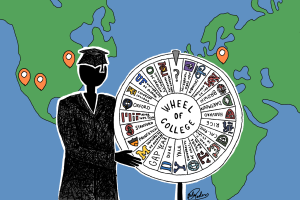AA Should Do What it Can…
…without changing our fundamental character
February 9, 2022
Editor’s Note: Readers brought to our attention unclear language in an earlier version of this story which gave an impression that was not intended by the author. As an editorial staff, we evaluated the critique and found it to have merit. We have worked with the author to clarify the language in this current version of the article to address the concerns of our readership. We always welcome written responses to our articles and strive to publish a wide range of viewpoints especially on challenging topics.
The 2020s have included an overdue rejuvenation of the civil rights movement. The result is a spotlight shining upon the elements of institutional racism that have been embedded into our culture. For the better, it is about time this light shines upon our school. As my classmate and Advocate opinion editor Neil Mahto points out, it is our obligation to combat this racism that continues to exist in our community. Neil’s sternly written call to action was necessary. I was inspired by the issues he brought up, but I think that some of his solutions may have unintended consequences, and I question the ways in which we, as a community and an institution, should go about solving these problems. In this article I will cover my concerns in response to Neil’s criticisms and suggestions, as well as share my ideas about how we can cautiously approach this challenging issue through education.
The first of two themes I would like to bring up is the extent to which we should blame the Academy for having racism on its campus. To blame an institution built in a racist country within a racist world for being racist is unfair. With racism systemically woven into our country’s history, it is difficult to expect the Academy to somehow construct a gate that prevents it from entering campus. As the article mentions, “Not only is our school as an institution not racism-free, but our school as a community is far from it as well.” While this statement is correct, there is simply no way for a high school to be immune to racism. Racist biases are cultivated from someone’s early years, family life, social media, peer groups, and countless other factors. Sadly, I have doubts that any school has the ability to create a completely racism-free community that exists within a systemically racist environment. To fault a school for its failure to accomplish this impossible task is overly critical.
Instead, the Academy should be measured by what it does to educate people on systemic racism, implicit bias, and how we can move forward into the world to be a part of the solution. For example, this year, and last year, while learning about U.S. history, my teachers made sure that my classmates and I understood that the racism that existed in our country, continues to exist, and is a factual matter not a matter of opinion. In fact, I have had teachers condemn some of the racist, classist, and deplorable beliefs of former president Trump. Likewise, with my advisor I have talked about the plague of recent Asian hate. These teachers, and their impact on me and my fellow students show that the leaders of this community, through education and awareness, are part of the solution, not the problem.
Head of School Julianne Puente has been criticized for limiting her role to helping “the children in her sphere” rather than fulfilling an “obligation to help everyone [she] can.” It is an unrealistic thing to ask that we help everyone we can all the time. When we walk down the street on a cold day, perhaps with a warm beverage in hand, or bundled together by an excessive amount of layers, and walk right by a homeless person, we are not doing all that we can to help them. Although some may not want to admit to it, that is simply not the world we live in, let alone an economic possibility. The fact of the matter is that if the Academy tried to exist for everybody, it wouldn’t exist for anybody. Instead, we should recognize that Ms. Puente influences hundreds of graduating students each year, sent out into the world to do their part in making it a better place.
The Academy may have a different purpose and mission, but at heart, the school is just another business. Even as a non-profit, the Academy nonetheless has a budget that relies heavily on donation-based endowments. Therefore, to say that the Academy is elitist and classist is to say that a restaurant that only serves paying customers is elitist. The economic reality is that the Academy can only provide education in return for enough money to keep themselves afloat. With the Academy as a private school giving an advanced education built on highly developed infrastructure and programs, comes the downside of funding the endeavor.
The question that necessarily follows is: what should the Academy do to combat institutional racism? Certainly, whenever Academy has the chance to condemn racist language, such as the use of the n-word, along with any other insulting, bigoted speech, it should immediately react strongly and swiftly. In fact, it is the Academy’s prerogative and duty to take disciplinary action. However, with such a policy, the question gets asked as to what defines deplorable speech. The line has to be set somewhere, and we risk being too radical in what we prohibit. The article references “Blue Lives Matter” merchandise being worn like it’s a fashion statement. If a student were to be forced to remove a “Blue Lives Matter” hat, would someone have to remove a “MAGA” hat– a hat representing Trump, a figure who stands in front of Blue Lives Matter advertisements, and other “anti-Black Lives Matter” material? With the exception of preventing hate speech, it is the job of the students to decide what is politically “correct,” not the institution. If anything, the Academy should foster beneficial conversations and greater understanding of politics within the student body. It should educate a student about the history and implications of their beliefs, giving them a greater foundation to stand on as a democratic citizen.
Finally, the proposal to fill Academy’s classes to a proportional demographic level parallel to that of Albuquerque, with acceptance based on a lottery, is rather unique. I think it is a great way to strive for a more racism-free community. However, there are many troubles that it would lead to. As many commented, if students were chosen by a lottery system, then their credentials and knowledge would not matter to the application process. These students would bring uneven levels of education with them and no curriculum would be able to account for their different needs. Likewise, the Academy would soon find itself in a financially stressful situation. With students being randomly selected by a lottery, there would simply be too many families unable to pay the current tuition. Although our tuition is expensive, so are the facilities, faculty, and programs that make the Academy nationally renowned. One must take a realistic approach and concede that if the Academy were to open its gates and outreach, it would suffer a loss of tuition revenue, and thereby a diminution in its ability to deliver the very good it most values.
My points all come from the perspective of a privileged white 16-year-old boy in America. Thus, my experiences in the Academy are distinct. The reason I write is not at all to challenge the idea that racism is at the Academy, but instead to discuss how it should be handled. A totally racism-free school in the midst of an institutionally racist culture is an unrealistic expectation. Thus, the assessment should not be whether the Academy has been successful in eliminating racism entirely. Instead, it should be measured by how far it goes to acknowledge the topic and implement methods to combat it while staying financially solvent and academically elite. As long as they continue to pursue that goal, by giving students summer reading books revolving around prejudice, teaching our full history, and allowing students to debate the roles of crucial issues such as racism in our community, then they are heading down the right path.









Miriam • Apr 24, 2022 at 1:02 pm
Instead, it should be measured by how far it goes to acknowledge the topic and implement methods to combat it while staying financially solvent and academically elite.
My favorite sentence! Great conclusion.